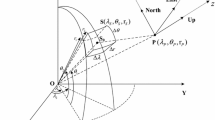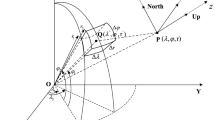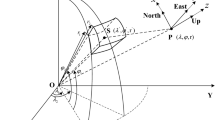Abstract
Proper understanding of how the Earth’s mass distributions and redistributions influence the Earth’s gravity field-related functionals is crucial for numerous applications in geodesy, geophysics and related geosciences. Calculations of the gravitational curvatures (GC) have been proposed in geodesy in recent years. In view of future satellite missions, the sixth-order developments of the gradients are becoming requisite. In this paper, a set of 3D integral GC formulas of a tesseroid mass body have been provided by spherical integral kernels in the spatial domain. Based on the Taylor series expansion approach, the numerical expressions of the 3D GC formulas are provided up to sixth order. Moreover, numerical experiments demonstrate the correctness of the 3D Taylor series approach for the GC formulas with order as high as sixth order. Analogous to other gravitational effects (e.g., gravitational potential, gravity vector, gravity gradient tensor), numerically it is found that there exist the very-near-area problem and polar singularity problem in the GC east–east–radial, north–north–radial and radial–radial–radial components in spatial domain, and compared to the other gravitational effects, the relative approximation errors of the GC components are larger due to not only the influence of the geocentric distance but also the influence of the latitude. This study shows that the magnitude of each term for the nonzero GC functionals by a grid resolution 15\(^{{\prime } }\,\times \) 15\(^{{\prime }}\) at GOCE satellite height can reach of about 10\(^{-16}\) m\(^{-1}\) s\(^{2}\) for zero order, 10\(^{-24 }\) or 10\(^{-23}\) m\(^{-1}\) s\(^{2}\) for second order, 10\(^{-29}\) m\(^{-1}\) s\(^{2}\) for fourth order and 10\(^{-35}\) or 10\(^{-34}\) m\(^{-1}\) s\(^{2}\) for sixth order, respectively.








Similar content being viewed by others
References
Álvarez O, Gimenez M, Braitenberg C, Folguera A (2012) GOCE satellite derived gravity and gravity gradient corrected for topographic effect in the South Central Andes region. Geophys J Int 190:941–959. https://doi.org/10.1111/j.1365-246X.2012.05556.x
Asgharzadeh MF, Von Frese RRB, Kim HR, Leftwich TE, Kim JW (2007) Spherical prism gravity effects by Gauss-Legendre quadrature integration. Geophys J Int 169:1–11. https://doi.org/10.1111/j.1365-246X.2007.03214.x
Asgharzadeh MF, Von Frese RRB, Kim HR (2008) Spherical prism magnetic effects by Gauss-Legendre quadrature integration. Geophys J Int 173:315–333. https://doi.org/10.1111/j.1365-246X.2007.03692.x
Balakin AB, Daishev RA, Murzakhanov ZG, Skochilov AF (1997) Laser-interferometric detector of the first, second and third derivatives of the potential of the Earth gravitational field. Izvestiya vysshikh uchebnykh zavedenii, seriya Geologiyai Razvedka 1:101–107
Baykiev E, Ebbing J, Brönner M, Fabian K (2016) Forward modeling magnetic fields of induced and remanent magnetization in the lithosphere using tesseroids. Comput Geosci 96:124–135. https://doi.org/10.1016/j.cageo.2016.08.004
Brieden P, Muller J, Flury J, Heinzel G (2010) The mission OPTIMA—novelties and benefit. Geotechnologien, science report no. 17, Potsdam, Germany, pp 134–139
Casotto S, Fantino E (2009) Gravitational gradients by tensor analysis with application to spherical coordinates. J Geodesy 83:621–634. https://doi.org/10.1007/s00190-008-0276-z
Cesare S, Aguirre M, Allasio A, Leone B, Massotti L, Muzi D, Silvestrin P (2010) The measurement of Earth’s gravity field after the GOCE mission. Acta Astronaut 67:702–712. https://doi.org/10.1016/j.actaastro.2010.06.021
Conway JT (2015) Analytical solution from vector potentials for the gravitational field of a general polyhedron. Celest Mech Dyn Astron 121:17–38. https://doi.org/10.1007/s10569-014-9588-x
Conway JT (2016) Vector potentials for the gravitational interaction of extended bodies and laminas with analytical solutions for two disks. Celest Mech Dyn Astron 125:161–194. https://doi.org/10.1007/s10569-016-9679-y
Deng XL, Grombein T, Shen WB, Heck B, Seitz K (2016) Corrections to A comparison of the tesseroid, prism and point-mass approaches for mass reductions in gravity field modelling (Heck and Seitz, 2007) and Optimized formulas for the gravitational field of a tesseroid (Grombein et al., 2013). J Geodesy 90:585–587. https://doi.org/10.1007/s00190-016-0907-8
Deng XL, Shen WB (2017) Formulas of gravitational curvatures of tesseroid both in spherical and Cartesian integral kernels. Geophys Res Abstr 19:93
D’Urso MG (2013) On the evaluation of the gravity effects of polyhedral bodies and a consistent treatment of related singularities. J Geodesy 87:239–252. https://doi.org/10.1007/s00190-012-0592-1
D’Urso MG (2014a) Analytical computation of gravity effects for polyhedral bodies. J Geodesy 88:13–29. https://doi.org/10.1007/s00190-013-0664-x
D’Urso MG (2014b) Gravity effects of polyhedral bodies with linearly varying density. Celest Mech Dyn Astron 120:349–372. https://doi.org/10.1007/s10569-014-9578-z
D’Urso MG (2015) The gravity anomaly of a 2D polygonal body having density contrast given by polynomial functions. Surv Geophys 36:391–425. https://doi.org/10.1007/s10712-015-9317-3
D’Urso MG (2016) A remark on the computation of the gravitational potential of masses with linearly varying density. VIII Hotine Marussi International Symposium on Mathematical Geodesy. Springer, Berlin Heidelberg, pp 205–212
Du J, Chen C, Lesur V, Lane R, Wang H (2015) Magnetic potential, vector and gradient tensor fields of a tesseroid in a geocentric spherical coordinate system. Geophys J Int 201:1977–2007. https://doi.org/10.1093/gji/ggv123
Elsaka B, Raimondo JC, Brieden P, Reubelt T, Kusche J, Flechtner F, Iran Pour S, Sneeuw N, Müller J (2014) Comparing seven candidate mission configurations for temporal gravity field retrieval through full-scale numerical simulation. J Geodesy 88:31–43. https://doi.org/10.1007/s00190-013-0665-9
ESA (1999) Gravity field and steady-state ocean circulation mission. ESA SP-1233(1), report for mission selection of the four candidate earth explorer missions, ESA Publication Division
Fantino E, Casotto S (2009) Methods of harmonic synthesis for global geopotential models and their first-, second- and third-order gradients. J Geodesy 83:595–619. https://doi.org/10.1007/s00190-008-0275-0
Flechtner F, Neumayer KH, Doll B, Munder J, Reigber C, Raimondo JC (2009) GRAF-a GRACE follow-on mission feasibility study. Geophys Res Abstr 11:8516
Fukushima T (2012a) Recursive computation of finite difference of associated Legendre functions. J Geodesy 86:745–754. https://doi.org/10.1007/s00190-012-0553-8
Fukushima T (2012b) Numerical computation of spherical harmonics of arbitrary degree and order by extending exponent of floating point numbers. J Geodesy 86:271–285. https://doi.org/10.1007/s00190-011-0519-2
Fukushima T (2012c) Numerical computation of spherical harmonics of arbitrary degree and order by extending exponent of floating point numbers: II first-, second-, and third-order derivatives. J Geodesy 86:1019–1028. https://doi.org/10.1007/s00190-012-0561-8
Sastry RG, Gokula AP (2016) Full gravity gradient tensor of a vertical pyramid model of flat top & bottom with depth-wise linear density variation. Symposium on the application of geophysics to engineering and environmental problems, pp 282–287. https://doi.org/10.4133/SAGEEP.29-051
Ghobadi-Far K, Sharifi MA, Sneeuw N (2016) 2D Fourier series representation of gravitational functionals in spherical coordinates. J Geodesy 90:871–881. https://doi.org/10.1007/s00190-016-0916-7
Grombein T, Seitz K, Heck B (2013) Optimized formulas for the gravitational field of a tesseroid. J Geodesy 87:645–660. https://doi.org/10.1007/s00190-013-0636-1
Grombein T, Luo X, Seitz K, Heck B (2014) A wavelet-based assessment of topographic-isostatic reductions for GOCE gravity gradients. Surv Geophys 35:959–982. https://doi.org/10.1007/s10712-014-9283-1
Grombein T, Seitz K, Heck B (2016) The rock-water-ice topographic gravity field model RWI_TOPO_2015 and its comparison to a conventional rock-equivalent version. Surv Geophys 37:937–976. https://doi.org/10.1007/s10712-016-9376-0
Gruber TH, Panet I, Johannessen J, Doll B, Christophe B, Sheard B, E.motion Team (2012) Earth system mass transport mission (e.motion): technological and mission configuration challenges. In: International symposium on gravity, geoid and height systems, GGHS2012, Venice, 9–12. Oct. 2012. http://www.espace-tum.de/mediadb/4540008/4540009/20121010_Gruber_Poster_emotion.pdf
Hamáčková E, Šprlák M, Pitoňák M, Novák P (2016) Non-singular expressions for the spherical harmonic synthesis of gravitational curvatures in a local north-oriented reference frame. Comput Geosci 88:152–162. https://doi.org/10.1016/j.cageo.2015.12.011
Heck B, Seitz K (2007) A comparison of the tesseroid, prism and point-mass approaches for mass reductions in gravity field modelling. J Geodesy 81:121–136. https://doi.org/10.1007/s00190-006-0094-0
Hirt C, Kuhn M (2014) Band-limited topographic mass distribution generates full-spectrum gravity field: gravity forward modeling in the spectral and spatial domains revisited. J Geophys Res Solid Earth 119:3646–3661. https://doi.org/10.1002/2013JB010900
Hirt C, Reußner E, Rexer M, Kuhn M (2016) Topographic gravity modeling for global Bouguer maps to degree 2160: validation of spectral and spatial domain forward modeling techniques at the 10 microGal level. J Geophys Res Solid Earth 121:6846–6862. https://doi.org/10.1002/2016JB013249
Hofmann-Wellenhof B, Moritz H (2006) Physical geodesy. Springer, Berlin
Holstein H (2002) Gravimagnetic similarity in anomaly formulas for uniform polyhedra. Geophysics 67:1126–1133. https://doi.org/10.1190/1.1500373
Kuhn M (2003) Geoid determination with density hypotheses from isostatic models and geological information. J Geodesy 77:50–65. https://doi.org/10.1007/s00190-002-0297-y
Kuhn M, Featherstone W (2002) On the optimal spatial resolution of crustal mass distributions for forward gravity field modelling. Gravity and geoid, pp 195–200
Kuhn M, Hirt C (2016) Topographic gravitational potential up to second-order derivatives: an examination of approximation errors caused by rock-equivalent topography (RET). J Geodesy 90:883–902. https://doi.org/10.1007/s00190-016-0917-6
Kuhn M, Seitz K (2005) Comparison of Newton’s integral in the space and frequency domains. In: A window on the future of geodesy. Springer, pp 386–391
Li Z, Hao T, Xu Y, Xu Y (2011) An efficient and adaptive approach for modeling gravity effects in spherical coordinates. J Appl Geophys 73:221–231. https://doi.org/10.1016/j.jappgeo.2011.01.004
Loomis BD, Nerem RS, Luthcke SB (2012) Simulation study of a follow-on gravity mission to GRACE. J Geodesy 86:319–335. https://doi.org/10.1007/s00190-011-0521-8
Nahavandchi H (1999) Terrain correction computations by spherical harmonics and integral formulas. Phys Chem Earth Part A Solid Earth Geodesy 24:73–78
Nagy D, Papp G, Benedek J (2000) The gravitational potential and its derivatives for the prism. J Geodesy 74:552–560. https://doi.org/10.1007/s001900000116
Panet I, Flury J, Biancale R, Gruber T, Johannessen J, van den Broeke MR, van Dam T, Gegout P, Hughes CW, Ramillien G, Sasgen I, Seoane L, Thomas M (2013) Earth system mass transport mission (e.motion): a concept for future earth gravity field measurements from space. Surv Geophys 34:141–163. https://doi.org/10.1007/s10712-012-9209-8
Reigber C, Luehr H, Schwintzer P (2002) CHAMP mission status. Adv Space Res 30:129–134. https://doi.org/10.1016/S0273-1177(02)00276-4
Ren Z, Chen C, Pan K, Maurer H, Tang J (2017) Gravity anomalies of arbitrary 3D polyhedral bodies with horizontal and vertical mass contrasts. Surv Geophys 38:479–502. https://doi.org/10.1007/s10712-016-9395-x
Rosi G, Cacciapuoti L, Sorrentino F, Menchetti M, Prevedelli M, Tino GM (2015) Measurement of the gravity-field curvature by atom interferometry. Phys Rev Lett 114:013001. https://doi.org/10.1103/PhysRevLett.114.013001
Roussel C, Verdun J, Cali J, Masson F (2015) Complete gravity field of an ellipsoidal prism by Gauss-Legendre quadrature. Geophys J Int 203:2220–2236. https://doi.org/10.1093/gji/ggv438
Rummel R (2003) How to climb the gravity wall. Space Sci Rev 108:1–14. https://doi.org/10.1023/a:1026206308590
Rummel R (2015) GOCE: gravitational gradiometry in a satellite. In: Freeden W, Nashed ZM, Sonar T (eds) Handbook of geomathematics. Springer, Berlin, pp 211–226
Shen WB, Deng XL (2016) Evaluation of the fourth-order tesseroid formula and new combination approach to precisely determine gravitational potential. Stud Geophys Geod 60:583–607. https://doi.org/10.1007/s11200-016-0402-y
Shen WB, Han J (2013) Improved geoid determination based on the shallow-layer method: a case study using EGM08 and CRUST2. 0 in the Xinjiang and Tibetan regions. Terr Atmos Ocean Sci 24:591–604. https://doi.org/10.3319/TAO.2012.11.12.01(TibXS)
Shen WB, Han J (2014) The 5\(\prime \quad \times \) 5\(\prime \) global geoid 2014 (GG2014) based on shallow layer method and its evaluation. Geophys Res Abstr 16:12043
Shen WB, Han J (2016) The 5\(\prime \quad \times \) 5\(\prime \) global geoid model GGM2016. Geophys Res Abstr 18:7873
Shen Z, Shen WB, Zhang S (2017) Determination of gravitational potential at ground using optical-atomic clocks on board satellites and on ground stations and relevant simulation experiments. Surv Geophys 38:757–780. https://doi.org/10.1007/s10712-017-9414-6
Silvestrin P, Aguirre M, Massotti L, Leone B, Cesare S, Kern M, Haagmans R (2012) The Future of the Satellite Gravimetry After the GOCE Mission. In: Kenyon S, Pacino CM, Marti U (eds), Geodesy for planet earth. In: Proceedings of the 2009 IAG Symposium, Buenos Aires, Argentina, 31 August 31–4 September 2009. Springer, Berlin, pp 223–230
Šprlák M, Novák P (2015) Integral formulas for computing a third-order gravitational tensor from volumetric mass density, disturbing gravitational potential, gravity anomaly and gravity disturbance. J Geodesy 89:141–157. https://doi.org/10.1007/s00190-014-0767-z
Šprlák M, Novák P (2016) Spherical gravitational curvature boundary-value problem. J Geodesy 90:727–739. https://doi.org/10.1007/s00190-016-0905-x
Šprlák M, Novák P (2017) Spherical integral transforms of second-order gravitational tensor components onto third-order gravitational tensor components. J Geodesy 91:167–194. https://doi.org/10.1007/s00190-016-0951-4
Šprlák M, Novák P, Pitoňák M (2016) Spherical harmonic analysis of gravitational curvatures and its implications for future satellite missions. Surv Geophys 37:681–700. https://doi.org/10.1007/s10712-016-9368-0
Starostenko VI. (1978). Inhomogeneous four-cornered vertical pyramid with flat top and bottom surface, in Stable computational method in gravimetric problems (in Russian). Navukova Dumka Kiev Russia, pp 90–95
Szwillus W, Ebbing J, Holzrichter N (2016) Importance of far-field topographic and isostatic corrections for regional density modelling. Geophys J Int 207:274–287. https://doi.org/10.1093/gji/ggw270
Tapley BD, Bettadpur S, Watkins M, Reigber C (2004) The gravity recovery and climate experiment: mission overview and early results. Geophys Res Lett 31:L09607. https://doi.org/10.1029/2004GL019920
Tóth G (2005) The gradiometric-geodynamic boundary value problem. In: Jekeli C, Bastos L, Fernandes J (eds) Gravity, Geoid and Space Missions: GGSM 2004 IAG international symposium Porto, Portugal August 30–September 3, 2004. Springer, Berlin, pp 352–357
Tóth G, Földváry L (2005) Effect of geopotential model errors on the projection of GOCE gradiometer observables. In: Jekeli C, Bastos L, Fernandes J (eds) Gravity, geoid and space missions: GGSM 2004 IAG international symposium Porto, Portugal August 30–September 3, 2004. Springer, Berlin pp 72–76
Tsoulis D. (1999). Analytical and numerical methods in gravity field modelling of ideal and real masses. C510, Deutsche Geodätische Kommission, München
Tsoulis D, Novák P, Kadlec M (2009) Evaluation of precise terrain effects using high-resolution digital elevation models. J Geophys Res Solid Earth 114:294–386. https://doi.org/10.1029/2008JB005639
Tsoulis D (2012) Analytical computation of the full gravity tensor of a homogeneous arbitrarily shaped polyhedral source using line integrals. Geophysics 77:F1–F11. https://doi.org/10.1190/geo2010-0334.1
Uieda L, Barbosa VC, Braitenberg C (2016) Tesseroids: Forward-modeling gravitational fields in spherical coordinates. Geophysics 81:F41–F48. https://doi.org/10.1190/geo2015-0204.1
Werner RA (2017) The solid angle hidden in polyhedron gravitation formulations. J Geodesy 91:307–328. https://doi.org/10.1007/s00190-016-0964-z
Wild-Pfeiffer F (2008) A comparison of different mass elements for use in gravity gradiometry. J Geodesy 82:637–653. https://doi.org/10.1007/s00190-008-0219-8
Wild-Pfeiffer F, Heck B (2006) Comparison of the modelling of topographic and isostatic masses in the space and the frequency domain for use in satellite gravity gradiometry. In: Proceedings of 1st international symposium of the IGFS. Gravity field of the earth, Istanbul, Turkey, pp 312–317
Wiese DN, Folkner WM, Nerem RS (2009) Alternative mission architectures for a gravity recovery satellite mission. J Geodesy 83:569–581. https://doi.org/10.1007/s00190-008-0274-1
Zheng W, Xu HZ, Zhong M, Yun MJ (2009) Accurate and rapid error estimation on global gravitational field from current GRACE and future GRACE follow-on missions. Chin Phys B 18:3597–3604
Zheng W, Hsu HT, Zhong M, Yun MJ (2012) Progress in international next-generation satellite gravity measurement missions. J Geodesy Geodyn 32:152–159
Zheng W, Hsu HT, Zhong M, Yun MJ (2013) Precise and rapid recovery of the Earth’s gravitational field by the next-generation four-satellite cartwheel formation system. Chin J Geophys 56:2928–2935. https://doi.org/10.1002/cjg2.20050
Zheng W, Xu HZ, Zhong M, Yun MJ (2014) Precise recovery of the Earth’s gravitational field by GRACE follow-on satellite gravity gradiometer. Chin J Geophys 57:1415–1423 (in Chinese)
Zheng W, Hsu H, Zhong M, Yun M (2015) Requirements analysis for future satellite gravity mission improved-GRACE. Surv Geophys 36:87–109. https://doi.org/10.1007/s10712-014-9306-y
Acknowledgements
We are very grateful to Prof. Tziavos and three anonymous reviewers, as well as Prof. Kusche, for their valuable comments and suggestions, which greatly improved the manuscript. This study is supported by National 973 Project China (Grant No. 2013CB733300), NSFCs (Grant Nos. 41631072, 41721003, 41429401, 41210006, 41174011, 41128003, 41021061) and Key Laboratory of GEGME fund (Grant No. 16-02-02)
Author information
Authors and Affiliations
Corresponding author
Appendices
Appendix A: Derivation of the 3D GC formulas in spherical integral kernels
The integral expressions of the GC functionals (e.g., the third-order derivatives of GP) given by a tesseroid mass body can be expressed in spherical coordinates in the local East–North–Up (ENU) topocentric reference system of the computation point \(P(\lambda _P ,\theta _P ,r_P )\). The expressions of the 10 GC functionals can be referred in Tóth (2005), Tóth and Földváry (2005), Casotto and Fantino (2009), Šprlák et al. (2016), Šprlák and Novák (2015, 2016, 2017).
After substituting the expressions of Table 4 into the expressions of the 10 GC functionals and mathematical simplification, the 3D integral expressions of GC functionals of a tesseroid in spherical coordinates in the local East–North–Up (ENU) topocentric reference system can be obtained as
As we adopt the same expressions of the 10 GC functionals as in Tóth (2005), Casotto and Fantino (2009), the representations of Eqs. (A1)–(A10) are equivalent to the Newton integrals as shown in Šprlák and Novák (2015). One could use the following Laplace identity equations to confirm the validity of the GC expressions (Casotto and Fantino 2009; Šprlák and Novák 2016; Šprlák et al. 2016):
Appendix B: 3D Taylor series approach for the GC functionals
In practical calculations, one could use these iterative relationships to simplify the calculation process; therefore, the 3D zero-order, second-order, fourth-order and sixth-order tesseroid expressions of the GC functionals can be given as:
Herein, the \(\Delta ^{6}\) term is provided, and the other lower terms (e.g., \(\Delta ^{0}\), \(\Delta ^{2}\)and \(\Delta ^{4})\) can be referred in Eqs. (13)–(15) of Shen and Deng (2016).
Herein, the Mathematica code file (Code.nb) for the detailed expressions of the 3D zero-order, second-order, fourth-order and sixth-order tesseroid formulas of the GC functionals is provided on a request addressing to W.B. Shen. The code file contains two parts: a) the expressions of the spherical integral kernels for the 10 different GC functionals; b) the processes of different order (zero-order, second-order, fourth-order and sixth-order) Taylor series expansion approach for the 10 different GC functionals. Taking the GC component \(V_{xxx}^{T3D} \) for example, the first part in the code file presents the expression of spherical integral kernels for \(V_{xxx}^{T3D} \) as \(Vxxx[G\_,\rho \_,\lambda p\_,\theta p\_,rp\_,\lambda 0\_,\theta 0\_,r0\_]\), which is the function definition in Mathematica; \(\lambda p,\theta p,rp\) and \(\lambda 0,\theta 0,r0\) are the spherical coordinates of the computation point P and the integration point \(S_0 \) with the symbol definition in the Mathematica code file. Then in the second part of the code file, it gives the different coefficient parameters expressions with different order (zero order with Vxxx000; second-order with Vxxx200,Vxxx020,Vxxx002; fourth order with Vxxx220, Vxxx022, ..., Vxxx004; and sixth order with Vxxx222, ..., Vxxx420, ..., Vxxx006) from Eq. (3). After substituting the coefficient parameters into Eqs. (B1)–(B5), it provides the final expressions for 3D zero-order (GCVxxx0), second-order (GCVxxx2), fourth-order (GCVxxx4) and sixth-order (GCVxxx6) tesseroid formulas for the GC component \(V_{xxx}^{T3D} \).
Rights and permissions
About this article
Cite this article
Deng, XL., Shen, WB. Evaluation of gravitational curvatures of a tesseroid in spherical integral kernels. J Geod 92, 415–429 (2018). https://doi.org/10.1007/s00190-017-1073-3
Received:
Accepted:
Published:
Issue Date:
DOI: https://doi.org/10.1007/s00190-017-1073-3




